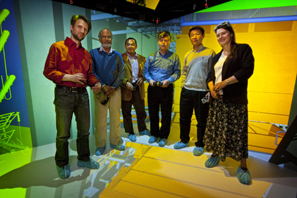 |
STONY BROOK, N.Y., April 11, 2011
The National Science Foundation has designated the Center for Dynamic Data Analytics (CDDA)—a partnership between Stony Brook University and Rutgers University—as a new Industry/University Cooperative Research Center (I/UCRC). The CDDA, based at Stony Brook’s Center of Excellence in Wireless and Information Technology (CEWIT) will have a base budget exceeding $2M over the initial five year period. It will unite academics and industry in an effort to improve IT technology and its relevance in the business world. The focus will be on innovative research and applications in the emerging field of dynamic data analysis based on the collaborative efforts between the two Universities and the member companies.
The Stony Brook CDDA’s corporate partners include CA Technologies, Northrop Grumman Corporation, SAP, Siemens, VJ Technologies, Softheon, Future Tech, Intrigma, DrChrono, Reveal Analytics, and General Sentiment. Additional businesses in the process of joining include IBM, Verizon, JP Morgan, Siemens, Applied Vision, FalconStor, Fatwire, Language Mate, XSB and Adobe.
“Our mission is to advance our knowledge on how to analyze and visualize massive, complex, multi-dimensional and multi-scale dynamic data,” explains Principal Investigator Arie E. Kaufman, Distinguished Professor and Chair of the Computer Science Department and Chief Scientist of CEWIT at Stony Brook University. “The end result will be novel science, algorithms, systems and applications that transform chaos (due to the size of the data) into knowledge.”
“CA Technologies is an IT management software and solutions company with expertise across all IT environments—from mainframe and physical, to virtual and cloud,” says Russ Artzt Vice Chairman of CA Technologies, who serves as the Chairman of CEWIT Advisory Board. “CA manages and secures IT environments and enables customers to deliver more flexible IT services [and] as such CA is interested in dynamic and large data analytics and specifically interested in collaborating with the Stony Brook CEWIT on data experimental and analytics. The CDDA and the associated NSF funding will perfectly complement these activities.”
The team of researchers from Stony Brook University and Rutgers University are experts in data analysis and visualization and have a long history of collaboration, while the corporate partners are leaders in their respective fields. “The center will close the essential loop between science and applications that is equally lacking between computer science research and IT development,” notes Professor Kaufman. “The algorithm and system design will be tested, validated, and improved based on the close collaboration and research between the two universities and industry. This cycle of design, testing and improvement can only be accomplished through a close University-Industry collaboration and is especially significant in this situation because of the complexity of the data and the absence of relevant algorithms and systems.”
“My colleagues Dorin Comaniciu, Kevin Zhou and Gareth Funka-Lea attended the CDDA planning meeting [at CEWIT] in January 2010, and are excited at the potential for CDDA to drive important innovations in data analytics,” says Silvano Dall’Asta, Chief Financial Officer of Siemens.
In addition to advancing the science of dynamic data analytics, the CDDA will also accelerate its transfer to industry by working closely with its business partners in the definition and prioritization of projects to be pursued by the Center and will seek involvement from world renowned faculty and excellent students.
“Adobe Systems Inc. is delighted to participate as an industry partner in the IUCRC Center for Dynamic Data Analytics,” says Jue Wang, Senior Research Scientist at Adobe. “The proposed scope of work around computer vision, computer graphics, context aware computing and distributed processing are extremely relevant to portfolios Adobe is building in digital media authoring and publishing solutions. Additionally, the goal of the Center to apply these novel data analytic approaches to healthcare, entertainment, environmental monitoring, and computer networks aligns with our mission of enabling new products and services in these industries.”
Zhen Wen of the IBM T.J. Watson Research Center in Hawthorne, New York, says, “The proposed scope of work around large-scale, distributed data processing and mining is extremely relevant to IBM’s portfolios in smarter planet solutions.”
Dall’Asta, of Siemens, notes, “We fully support the Center’s primary goal of accelerating both our understanding of the fundamentals of dynamic data analytics, and the transfer of these fundamentals into industry solutions.”
“Northrop Grumman Corporation is pleased to participate in the proposed center and is interested in the general area of dynamic data analytics and more specifically in multivariate analytics, multi-dimensional data visualization, advanced human/machine interfaces for managing multi-dimensional data,” says Lenny Poveromo, Director of Strategic University Alliances for Northrop Grumman.
“Our research will transform traditional research and significantly advance the computer science curriculum by improving the applications taught in our classes as well as having our industry partners lecture on the problems faced by industry,” notes Professor Kaufman. “Our students will spend time with our industrial affiliates as research assistants and through internships, and will thus improve their skills and design more sound and improved algorithms.”
The specific topics to be addressed by the Center are an emerging class of problems that are becoming increasingly important in many scientific and industrial areas, including computer science (e.g. cloud computing), biology, security, linguistics and the environmental sciences—all of which are confronted with analytics of massive and dynamic data. Ultimately, this endeavor will lead to new product development by the industrial partners in the area of dynamic data analytics. “The CDDA will transform traditional research in computer science and will have far-reaching consequences for both industry and homeland security,” notes Professor Kaufman.
